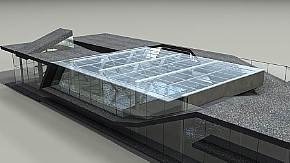2003.01.18 15:52
Re: Libeskind on CR tonight
Could it now be clear that nothing at Ground Zero will ever come close to what was there before, and certainly in no way capture the same intensity of event that September 11, 2001 was? If that's the case, how does one design something that is already destined to be lacking, except for the media hype. And given all the hyper media attention surrounding Ground Zero and its renewal design, one would think that the rebuilding of Hiroshima and Nagasaki would be in all the history books as a(n atomically) powerful precedent clearly explaining what such renewal really means and how to do it properly.
| |
2006.01.18 13:00
what is the good source to study folding architecture?
And here I thought that folding architecture had to do with simply taking a building plan and then folding it. Boy, I'm glad I never told anyone else this before because they'd surely think I was just plain stupid. I mean, I didn't know that the point was not so much to fold, but rather to tie architecture up in theoretical knots where even the architects doing it don't even know that what they are really doing is advertising (more than selling) what they think is a definite Zeitgeist reality. And what? Now it's just a quondam trend or fad that's still over-intellectualized.
| |
2006.01.18 14:38
what is the good source to study folding architecture?
This is the kind of folded architecture I like:

MVRDV, Sloterpark Swimming-pool, 1994
2006.01.18 16:08
what is the good source to study folding architecture?
James Stirling used to talk about taking an evolutionary approach to architectural design, rather than take a revolutionary approach to architectural design.
rhetorical question:
Is folded architecture evolving, or is it extinct?
| |
2006.01.18 17:39
what is the good source to study folding architecture?
MMatt wrote:
"What French is trying to make sure everyone understands here is that "folding" isn't a technique or a style, it's an entire school of thought (philosophically) with just as much theory and thick readings to defend/quantify it as any decon or other pomo sub-strands."
Personally, I've lost most of the confidence I've ever had in this type of sentiment/position as it relates to architectural design. Nonetheless, what MMatt wrote does reflect how most student architects are now trained to think about design, technique or style.
Yet, when it really comes down to an architectural design, folding architecture really does boil down to what it looks like. So, as far as I'm concerned, folding architecture is just another form, in the long history of forms, that architecture can take on, and, like jlxarchitect says, "if it can solve my office's project's problem, then it is Ok to use."
Otherwise, the notion of "an entire school of [failed?] thought" is stillborn, rather than being something within the evolutionary continuum of architectural design. And just because it's what is taught in school doesn't necessarily make it the truth. For example, the "Metabolist" architects of Japan talked a lot about architecture reflecting "life giving" forms, while at the same time appearing oblivious to the fact that metabolism as a operation is a creative/destructive duality. Likewise, everything Tafuri and Eisenman said/say about Piranesi's Ichnographia Campus Martius is just plain incorrect, yet their mistakes are taught and published over and over again.
I hope you all now understand what I mean by saying that I've lost confidence...
| |
12011801 St. Peter's Basilica horizontal windows with domestic elevations
2071i00
17011801 Parthenon column bench table model 5233 Arbor Street plan IQ45 2166i26
17011802 5233 Arbor Street plans model IQ45.02 plans 2166i27 b
17011803 5233 Arbor Street plans model Curatorium exhibition IQ45.02 site plan 2166i28 b
17011804 Maison Dom-ino model 5233 8415 plans Ury Farm site plan 2166i29 b c
17011801 OMA Bibliotheque Alexis de Tocqueville
18011801 atypical atemporality Philadelphia plan model working data 2467i12 b
|